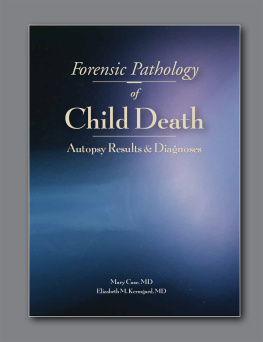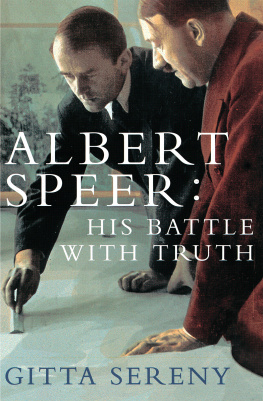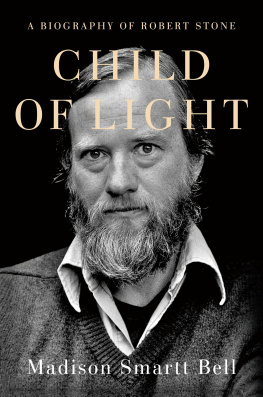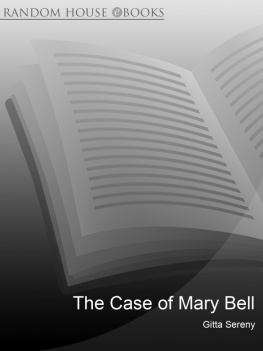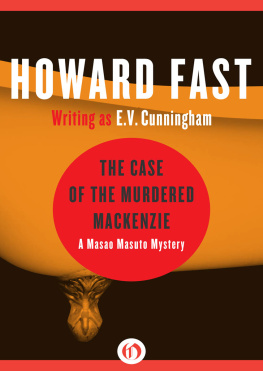Gitta Sereny - Case of Mary Bell. A Portrait of a Child Who Murdered
Here you can read online Gitta Sereny - Case of Mary Bell. A Portrait of a Child Who Murdered full text of the book (entire story) in english for free. Download pdf and epub, get meaning, cover and reviews about this ebook. year: 1995, publisher: Random House, genre: Detective and thriller. Description of the work, (preface) as well as reviews are available. Best literature library LitArk.com created for fans of good reading and offers a wide selection of genres:
Romance novel
Science fiction
Adventure
Detective
Science
History
Home and family
Prose
Art
Politics
Computer
Non-fiction
Religion
Business
Children
Humor
Choose a favorite category and find really read worthwhile books. Enjoy immersion in the world of imagination, feel the emotions of the characters or learn something new for yourself, make an fascinating discovery.

- Book:Case of Mary Bell. A Portrait of a Child Who Murdered
- Author:
- Publisher:Random House
- Genre:
- Year:1995
- Rating:5 / 5
- Favourites:Add to favourites
- Your mark:
- 100
- 1
- 2
- 3
- 4
- 5
Case of Mary Bell. A Portrait of a Child Who Murdered: summary, description and annotation
We offer to read an annotation, description, summary or preface (depends on what the author of the book "Case of Mary Bell. A Portrait of a Child Who Murdered" wrote himself). If you haven't found the necessary information about the book — write in the comments, we will try to find it.
Case of Mary Bell. A Portrait of a Child Who Murdered — read online for free the complete book (whole text) full work
Below is the text of the book, divided by pages. System saving the place of the last page read, allows you to conveniently read the book "Case of Mary Bell. A Portrait of a Child Who Murdered" online for free, without having to search again every time where you left off. Put a bookmark, and you can go to the page where you finished reading at any time.
Font size:
Interval:
Bookmark:
CONTENTS
In December 1968 two girls Mary Bell, eleven, and Norma Bell, thirteen (neighbours, but not related) stood before a criminal court in Newcastle, accused of strangling, within a six-week period, Martin Brown, four years old, and Brian Howe, three. Norma was acquitted. Mary Bell, the younger but infinitely more sophisticated and cooler of the two, was found guilty of manslaughter rather than murder because of diminished responsibility and was sentenced to detention for life. Step by step, the extraordinary murders, the events surrounding them, the alternately bizzare and nonchalant behaviour of the two girls, their brazen offers to help the distraught families of the dead boys, the police work that led to their apprehension, and the trial itself are grippingly re-created in this rare-study of the wanton murder of child by child. What emerges with equal force is the inability of society to anticipate such events and to take adequate steps once disaster has struck.
Gitta Sereny is of Hungarian-Austrian extraction and is trilingual in English, French and German. During the Second World War she became a social worker, caring for war damaged children in France. She gave hundreds of lectures in schools and colleges in America and, when the war ended, she worked as a Child Welfare Officer in UNRRA displaced persons camps in Germany. In 1949 she married the American Vogue photographer Don Honeyman and settled in London, where they brought up a son and a daughter and where she began her career as a journalist.
Her journalistic work is of great variety but has focused particularly on the Third Reich and troubled children. She has written mainly for the Daily Telegraph Magazine, the Sunday Times, The Times, the Independent and the Independent on Sunday Review. She has also contributed to numerous newspapers and magazines throughout the world.
Her other books are The Medallion, a novel; The Invisible Children, on child prostitution; Into that Darkness, on Franz Stangl, commandant of the Treblinka extermination camp; and, forthcoming, a biographical re-evaluation of Albert Speer. Gitta Sereny died in June 2012.
... As more exposed to suffering and distress;
Thence also, more alive to tenderness.
To Don
When I first saw Mary Bell, on 5 December 1968, the opening day of her trial at the Newcastle upon Tyne Assizes, I was there to report for the Daily Telegraph Magazine. I had recently undertaken to write a book on cruelty to children, and this strange case of the alleged murder by two girls, one thirteen, the other eleven, of two small boys, one four and one three, seemed a possible extreme example of cruelty by child to child.
But as I sat through the nine days of the trial, my purpose changed. In Court and in the press, Mary Bell was called a fiend and a Svengali. The Court would decide that sheand basically she alonehad committed the murders, and when the other child was acquitted, the whole country seemed to breathe a sigh of relief. The older girl being found innocent created an equation acceptable and even welcome to society: fate, or some terrible wrath of God, had produced a freak: one monstrous child, a bad seed, the uniqueness of whose evil could be seen as confirming the probity and virtue of society at large.
My difficulty, almost from the first day, was that I could not believe it. I had, very quickly, met the families of the little boys who had been killed and their pain was atrocious to see. And, of course, I knew that one or both of the girls had killed four-year-old Martin and three-year-old Brian. But somehow I could not associate the concept of evil with Mary Bell. In the context of the events, the suffering of the small boys parents, and the anger, not to say panic, in the media, there was one, to me overriding, impression I knew I would not be able to express in the articles I was commissioned to write. But it was precisely this impression that would change my original plan and would bring me to write this book. This feeling, much easier to describe today when, twenty-six years later, we have lived through the violent Jamie Bulger murder, was that the murder of the two little boys in Newcastle was not at all an illustration of cruelty by child to child.
There was a strange absence of violence in those murders whichand this is what one could not say at the timewere carried out, it seemed to me, almost with tenderness. This inversion, even perversion of emotion, I know, is as frightening as anger, and in these circumstances perhaps even more puzzling. But somehow I could not reconcile it with evil: to me, this strange, intelligent and isolated child just seemed horribly hurt.
Twenty-six years later, in Preston, at the Bulger trial, as it became known all over the world, we would find striking parallels but equally significant disparities.
Here too, two ten-year-old boys had accused each other of kidnapping and torture, but both denied having initiated the killing. The vast difference, however, was that in this case the victim was a child only just out of babyhood, entirely unknown to either of the boys, and was killed, not as a dreadful game, not out of some aberrant sense of curiosity, but with a ferocity really beyond human understanding. Not surprisingly, perhaps, in the absence of any explanation whatsoever, the vox populi, yet again, decried the two child perpetrators as evil.
There were further parallels between these two cases, almost three decades apart. The most important one (because of which my publishers and I have decided to add my report on the Bulger casewritten in February 1994 for the Independent on Sunday Reviewas an annexe to this book) is the total bewilderment which the court and jury in both these significant cases manifested when they were confronted with the childrens testimonies.
This bewilderment was and is symptomatic of the unfitness of that formal venue for the trial of children, even for murder. And the identical reactions of the court and public opinion in 1968 and 1993 also demonstrated how terribly little we have learned in a quarter of a century, how little progress we have made.
In 1968, I had become increasingly concerned each day of Mary Bells trial about the incomprehension and the partisanship of the Judge. In 1993, even though the Judge in the Bulger case was infinitely more knowledgeable and professional, and clearly aware of the deficiencies in the proceedings, his actions and decisions were inevitably determined by the system he served. For me, sitting through an almost exact replica of the 1968 trial, much of it had a distressing quality of dj vu. And during the breaks and the sixteen evenings of the trial days, I found, yet again, that every lawyer, every court official, virtually every police officer and every member of the media I spoke with, had grave misgivings about the case and, yes, the venue of the trial.
In Newcastle, Brian Roycroft, one of the finest social workers in the country, took over as Childrens Officer in the summer of 1968. Not long afterwards he became Director of Social Services and, thanks to him, I received enormous help from all who worked there.
In Liverpool, where the police and voluntary organizations readily responded to me, the local authority social workers and the teachers were, not surprisingly perhaps, officially gagged.
But even where officials consented to speakin 1968
Next pageFont size:
Interval:
Bookmark:
Similar books «Case of Mary Bell. A Portrait of a Child Who Murdered»
Look at similar books to Case of Mary Bell. A Portrait of a Child Who Murdered. We have selected literature similar in name and meaning in the hope of providing readers with more options to find new, interesting, not yet read works.
Discussion, reviews of the book Case of Mary Bell. A Portrait of a Child Who Murdered and just readers' own opinions. Leave your comments, write what you think about the work, its meaning or the main characters. Specify what exactly you liked and what you didn't like, and why you think so.

